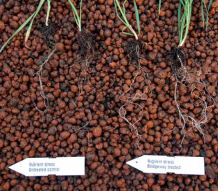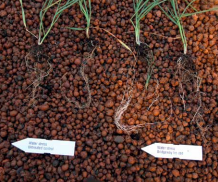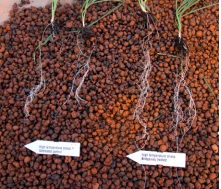Just how essential are individual amino acids in helping plants cope with environmental stress? Taking a close look at the effects of amino acid biostimulants on early root and shoot growth in winter wheat and spring barley, we explore here the role some of the key amino acids play in resilience, yield, and overall plant health.
The impact of climate change is beginning to have an adverse effect on our crops. Never was this more apparent than during the long, hot summer of 2018. In a year of unprecedented weather extremes and increased challenges to plant health, last summer was one of the hottest on record for the UK, up there with the heatwave of 1976. Alarmingly, findings in December’s Climate Predictions Report from the Met Office confirmed what many of us already suspected; the UK can expect warmer, wetter winters and hotter, drier summers, with an increase in frequency and intensity of extremes. As demand on growers and their crops becomes ever more fierce, agricultural productivity is facing threats from a variety of stress factors, many associated with global warming.
It’s clear that we need to change the way we think about crop husbandry. Crops will need to adapt to extreme weather patterns, exhibiting more resilience to a wider range of conditions than has been necessary in the past. This isn’t an issue we need to think about in the distant future; it’s affecting growers and their crops right now. We already know that environmental stress conditions can have a serious effect on plant fitness and productivity. At Interagro, we are certain that unlocking the genetic potential of plants and increasing the resilience of crops to climate change are the most pressing agricultural challenges of our time. This is where amino acid biostimulants come in.
The building blocks of all living cells, amino acids combine in infinite variations to produce various essential proteins for healthy growth and development. Under ideal conditions, plants synthesise all 18 L-amino acids they require, using carbon and oxygen in the air, hydrogen from water and nitrogen from the soil. This is what makes soil quality and nutrient density so important to overall plant health. But what happens when plants aren’t getting what they need from their environment? Used in the right way, amino acid biostimulants help optimise the metabolic efficiency of plants and aid resilience to abiotic stress (detrimental effects caused by non-living factors including temperature, light and moisture), thus improving yield, quality and overall plant health. Still relatively new on the scene, we’re only just beginning to understand the potential of these exciting incremental technologies.

Putting amino acids to the test
Following positive results seen on farms which adopted amino acid biostimulants in 2018, we sought to deepen our understanding of the role of amino acids in plant health and explore the implications of supplementing crops. Enforcing abiotic stress deliberately allows us to really test the physiological implications on the plant and demonstrate how such a product can assist. To explore this in a controlled environment, we called on the expertise of bioscientist Dr. Stephen Rossall from The University of Nottingham. Over several years Steve has looked at a range of foliarapplied biostimulant products on early root and shoot growth. These comprised materials as diverse as: bacterial agents, inorganic molecules, phytohormone products, amino acids and carbohydrates. On the value of biostimulants, Steve had this to say: “When weather patterns are more variable, the need for consistent crop establishment becomes more important. Application of an effective biostimulant can give a yield response in all seasons, but additional benefits may be seen in ‘difficult seasons’ thus providing enhanced yields and more consistency for farmers.”
Our Bridgeway product contains all 18 L-amino acids required to assist with plant functions and healthy development. Steve examined the impact of early applications of Bridgeway on root and shoot growth in both good growing conditions and under various forced stress scenarios. The results of his experiments are extremely encouraging… In the first (non-stressed) experiment, treatments were applied to wheat and spring barley at two concentrations; Bridgeway 1.0 L/ha and Bridgeway 2.0 L/ha. The effects of the treatment were significant, particularly in barley and wheat roots, where the higher concentration saw average dry weights boosted by 41% and 42% respectively. However, it was when the plants were subjected to conditions of abiotic stress that things got really interesting… Steve concentrated on wheat for the stressed experiments, applying Bridgeway at the higher concentration 2.0 L/ha.
Nutrient stress

Steve synthesised nutrient stress by feeding the plants at a 10% rate of the standard feed. Here the Bridgeway made a conspicuous difference, increasing the average dry weight of shoots by 27% and roots by 29%.
Drought stress
In this experiment, wheat was given the standard feed but was subject to irrigation only every fourth day, rather than daily, or when the plants start to show drought symptoms if that occurred earlier. In this instance, Bridgeway made a huge difference, pushing up average dry weight by 24% in shoots and an incredible 48% in roots.

High temperature stress
The results seen here were still more extraordinary. In the heat stress experiment, plants were grown at a constant 30˚C with standard feed and irrigation. The average yield of roots treated with Bridgeway was almost double that of the untreated control at 49%. Shoots saw a boost of 24%.

Overall, the biostimulatory effects on early growth were very positive when early applications were made. While there is a clear indication that using Bridgeway stimulated both root and shoot growth, larger effects were consistently observed on root growth. This could be of huge benefit to crops during early establishment. The benefits of applying Bridgeway were most dramatic when the crop was under abiotic stress. Crops typically experience some sort of stress early on, particularly in the spring when soils can be dry and nutrients are locked up. Building structure and root biomass early in the life of the crop will help it be more resilient to environmental stresses and topping up with Bridgeway later in the season will ensure those benefits manifest in the yield.
We were blown away by these results, and excited about what they could mean for the future – particularly if, as predicted, summers like the one seen in 2018 are soon to become the norm. Steve was also pleased with his findings, saying, “I am confident that Bridgeway is in the premier league of the biostimulants I have tested.” His sentiments seem to echo that shared by growers who trialled Bridgeway across a variety of crops last summer.
On the ground
It’s clear that in the right situation, amino acid biostimulants have the potential to add substantial yield and quality benefits.To prove this, we went straight to the source; the growers. From barley to brussels sprouts, Bridgeway has already been used to push performance in a range of crops in stressed and nonstressed on-farm trials. Bridgeway has consistently shown benefits in sugar beet, with yields increasing by up to +11 t/ha; replicated trials in 2018 have shown that three applications of Bridgeway at 2 L/ha produce the very best results. In root crops, Bridgeway increased speed of bulking (+2.2 t/ha per week) and yield (+12.4 t/ha) in potatoes, improving plant health and helping the crop better cope with stress.
Bridgeway also trialled in onions in 2018, where all treatments increased green leaf area, yield per bulb and overall yield. Here, the best results were shown to come from three applications of Bridgeway at 2.0 L/ ha. Three applications of Bridgeway also produced significantly higher yields in winter wheat grown on heavy clay; between +0.84 and 2.21 t/ha when subject to waterlogging, drought or extreme temperature stress. So, the key question; how do amino acids work?
Breathing new life into your plants
Plants require a good amount of certain key amino acids to assist with plant functions and healthy development. Under abiotic stress, for example, plants increase production of L-Proline, strengthening the cell walls and increasing resistance to weather extremes. Plants also rely on L-Glycine and L-Glutamic acid to produce chlorophyll and absorb the light needed for photosynthesis; a plant’s single most important chemical process. Then there’s nutrient uptake. Tiny molecules that can move easily through cell membranes, the amino acids L-Glycine and L-Glutamic acid are able to bond with certain nutrients, making them available to the plant. Their ability to bind excess metals also means they are able to reduce metal toxicity.
Certain amino acids act as precursors to hormones and growth factors; L-Tryptophan is involved in rooting, growth and development; L-Methionine is a precursor to ethylene which stimulates ripening, and L-Arginine is a precursor to cytokinin production involved in cell growth, auxiliary bud growth and leaf senescence. As one of the most critical phases of development, pollination and fruit formation requires high levels of amino acids. L-Histidine helps with ripening; L-Proline increases pollen fertility; L-Lysine, L-Methionine and L-Glutamic Acid increase germination; L-Alanine, L-Valine, and L-Leucine improve fruit/grain quality.
Bridgeway contains the key amino acids in higher concentrations than animal-based amino acids:
• L-Tryptophan (+40%) – fundamental precursor for rooting
• L-Glutamic Acid (+39%) – Stimulates plant development, increases resistance to weather stress. Precursor of other amino acids. Helps adsorption of inorganic N
• L-Aspartic Acid (+46%) – fundamental in metabolic processes and source of N
• L-Serine (+43%) – increased resistance to stress
• L-Lysine (+33%) – fundamental in stimulating photosynthesis
The product also includes organic (ready-to-use source) nitrogen. A major constituent of chlorophyll, nucleic acid (DNA and RNA) and amino acids, nitrogen is arguably the most important nutrient for plant development. Limited nitrogen supply has negative consequences for plants including reduced leaf area, chlorophyll levels, biomass, photosynthetic rate and yield of protein and oils. Transporting nitrogen to newly-developing flowers is a significant determinant for flower set, growth and abortion and is essential for proper development of male and female gametophytes. Since the application of nitrogen fertilisers to crops is limited, the additional boost from Bridgeway will be particularly useful, especially if the crop is deficient.
Recommendations 2019
Biostimulant products like Bridgeway are a valuable tool, helping us protect plants from abiotic stress and reach their full genetic potential in the field. To optimise plant health throughout the life of the crop, we would recommend applying 2.0 L/ha Bridgeway during crop establishment, then a top-up during key stages of development and ahead of any anticipated stress event. To discuss individual scenarios or to request our product, timing and case study guides, please feel free to get in contact with us at info@interagro.co.uk.